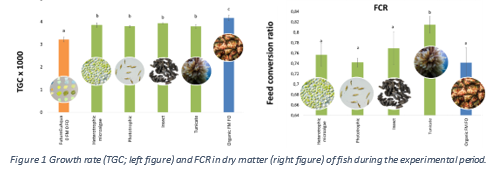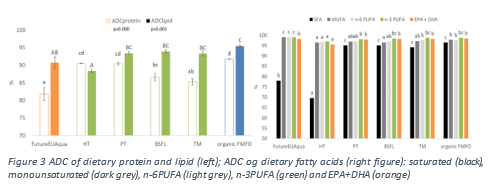PERFORMANCE OF NOVEL LOW TROPHIC RAW MATERIALS IN ATLANTIC SALMON Salmo salar DIETS
Introduction
Ma ny different raw materials are considered as candidates for replacing fish meal (FM) and fish oil FO) in diets for salmonids, particularly focusing on locally produced low trophic level organisms with higher sustainability and circular economy potential. However, most of these novel raw materials differ from fish , containing e.g., high levels of complex carbohydrates or fully saturated triglycerides, and their nutritional value and nutrient bioavailability must be investigated before their use in commercial feeds.
Materials and Methods
In the current study, a control diet was created using high quality organic FM (25% in the diet) and FO (10% in the diet). L arge parts of FM, FO or both were replaced by one of the following test ingredients: tunicate (Ciona intestinalis) meal, black soldier fly larvae meal (Hermetia illucens ), cell wall disrupted phototrophic microalga Phaeodactylum tricornutum biomass, and spray dried heterotrophic microalga Schizochytrium limacinum biomass to create four test diets TM, BSFL, PT and HT, respectively . In a fifth diet (FutureEUAqua 0FM0FO ) all the above test ingredients were combined at the same levels as when tested alone, and no FM or FO was used. The diets were balanced for protein, essential amino acids, EPA+DHA and n-3/n-6 ratio, phospholipids, and soluble P , using wheat and horse beans, crystalline amino acids, plant oils, lecithin, and monosodium phosphate, respectively. The experimental diets were fed to triplicate salmon smolt groups of 50 fish per tank, with initial mean fish body weight 142 and final mean body weight 433 g. Dietary effects on tissue composition, nutrient ADC, fish biometrics, skin histology and blood chemistry were evaluated.
Results and Discussion
We saw significantly higher growth rate in the control group as compared to the test groups. TGC was similar and high (approx. 4) among the single test ingredient experimental groups and higher as compared to the FutureEUAqua treatment lacking FM and FO . Growth mostly correlated with feed intake, thus FCR was similar among treatments and low FCR (Fig 1). TGC correlated significantly and positively with serum K, ASAT, ALAT and CK. ADC was significantly affected by dietary treatment for most nutrients analyzed except Cu, Zn, Se, Mn and 22:0.
Dermis was thinner for the FutureEUAqua fish, dense connective tissue (DCT) was thicker for the BSFL group than the PT group and scales areas followed a similar pattern as dermis with lowest values for the FutureEUAqua fish (Fig 2). There was no effect on epidermal area or number and area of mucous cells, and the epidermis of fish studied looked healthy.
The diets with alternative protein sources (BSFL and TM) had lower ADC of protein (86.6 and 85.3%, respectively ) than the FM (91.7%) control. Their combination reduced ADC of protein further in the FutureEUAqua treatment (81.7%). Similar pictured showed the ADC of most amino acids, though their dietary levels were balanced, which may indicate suboptimal processing of these new raw materials still in development (e.g., excess heating). ADC of lipids was lowest in the HM diet, as reported in short term trials before (Kousoulaki et al., 2015) due to the high levels of tripalmitin in HM oil (Bogevik et al.,2018) . HM had also slightly lower ADC of MUFA, n-6PUFA, n-3PUFA and EPA+DHA as compared to the control and test diets, except the FutureEUAqua which had surprisingly the highest levels among all the groups (Fig 3).
Acknowledgments
This study is part of the FutureEUAqua project which has received funding from the European Union’s Horizon 2020 research and innovation programme under grant agreement 817737.
References
Bogevik, A.S., Nygren, H., Balle, T., Haugsgjerd, B.O., Kousoulaki, K., 2018. Enzymatic interesterification of heterotrophic microalgal oil with rapeseed oil to decrease the levels of tripalmitin. European Journal of Lipid Science and Technology, 2018, 1800063, 10 p.


